Goodbye Winter, Hello Spring!
The first day of spring, this year, will fall on 20th March, yet all over Montrose Basin Wildlife Reserve there are tantalising signs that a new season has already started to arrive. In the wooded and hedgerow banked areas around the Lurgies, Tayock and Mains of Dun, carpets of snow drops have been brightening visitor’s walks for several weeks. Enthusiastic daffodil heads are already starting to push their way through the warming ground, with a canary yellow parade ushering cars under the railway bridge at Rossie Island. Around the Visitor Centre our garden birds, house and tree sparrows, blue tits, chaffinches and blackbirds, are beginning to collect nesting materials, explore nest boxes and seek out mates all in their brightened breeding plumage.
However, this point of the year also brings a twinge of dolefulness to Visitor Centre staff and volunteers alike. In the middle of March, we have to prepare ourselves to bid farewell to our resident feathered celebrity – the kingfisher. Throughout winter, without fail, she has brightened our days fishing from her perch in the main pond or, with a lightning quick topaz flash, flitting across the saltpans to delight patient birdwatchers in the Bank of Scotland Hide. At this time in the year, she’ll be gearing up to travel over to the Lurgies to breed. There, she will lay between 2 and 10 white eggs within a cavity burrow in the riverbank. She may raise up to three broods, if the season allows and will return to her territory in the autumn.
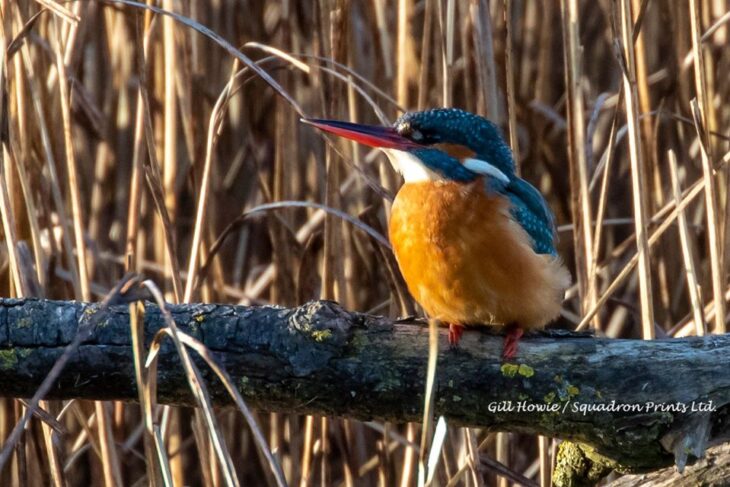
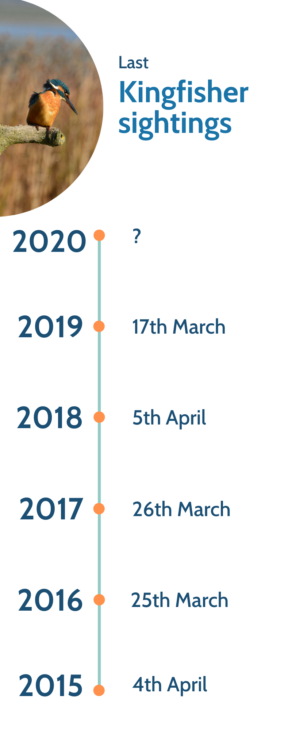
So, when can we expect to say goodbye to our kingfisher?
I’ve taken a look at our sightings records for the past 5 years (2015 – 2019), to determine when the last kingfisher sighting has been. Over the last 5 years, the window between first kingfisher sightings has been 20 days. Last year was the earliest date she departed us, on 17th March. Notably, March 2019 was the 10th warmest on record and the milder temperatures may have instigated earlier breeding behaviours in many bird species. Interestingly, the previous year (2018), we enjoyed views of the kingfisher until as late as 5th April. That year saw anticyclone Hartmut, or the dreaded ‘Beast from the East’, bring bitterly cold temperatures and heavy snowfall to much of the UK, including Montrose Basin. It’s no surprise, therefore, that our kingfisher delayed her travels to the breeding grounds. This year has been quite mild, but exceptionally wet! Last month was the second wettest February on record (behind 1990), with 275.6 mm falling in one month alone. It will be difficult to predict how this will affect the kingfisher’s decampment time. As we can see from previous years, poorer weather has usually resulted in a later exit date.
Spring Brings the Migrants
It’s not all doom and gloom though, our last sighting of blue and orange feathers is often swiftly followed by our first sighting of hovering brown and white ones – our ospreys! Ospreys migrate from the west coast of Africa, namely Senegal, to Scotland and arrive back as early as mid-March. For more information about the migration of the ospreys at Montrose Basin, take a look at our Blog here.
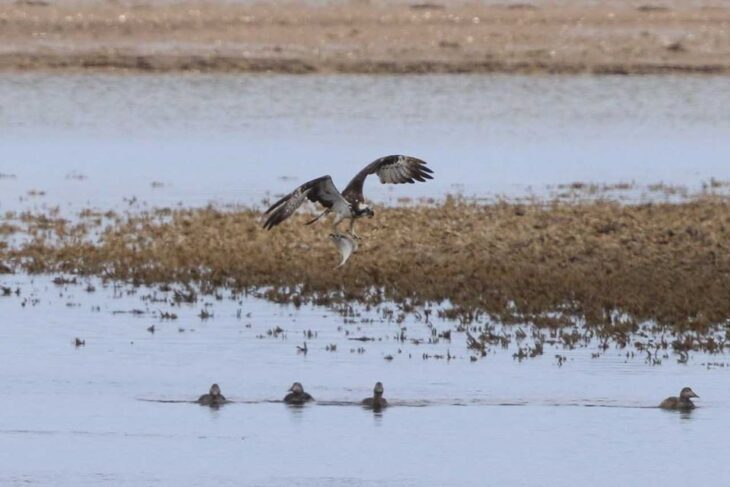
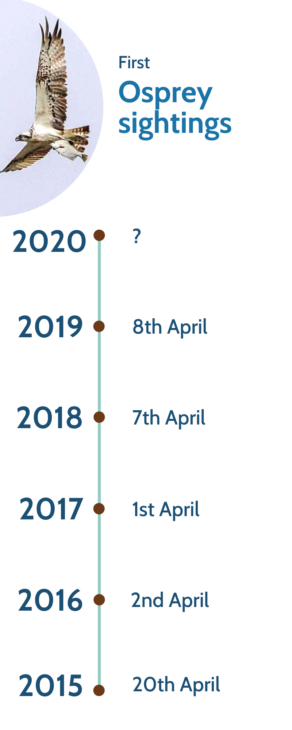
Looking at our sightings records for ospreys at Montrose Basin we can see that the earliest sighting, since 2015, was 1st April. Over the past 5 years, the osprey return has been remarkably consistent, with arrival dates falling within days of one another. (Curiously, the window between first osprey sightings between 2015 and 2019 is also 20 days!). Osprey numbers, as a whole, have been increasing over the last decade with approximately 240 breeding pairs in the UK. So, it’s not surprising that we’ve been seeing ospreys towards the beginning of April, rather than the end. More ospreys, means more claimed fishing and breeding territories.
Another arrival that heralds the change in seasons, are sand martins. The smallest of the martin and swallow family, sand martins migrate from sub-Saharan Africa back to Montrose Basin to nest in our sand martin wall, which is easily viewed from the Visitor Centre windows. Our sand martin wall was built in 2002 and is split into 4 sections of numbered nesting holes. The numbering system allows us to tracks nesting patterns and sand martin numbers. For more information about our sand martins, you can read our Blog here.
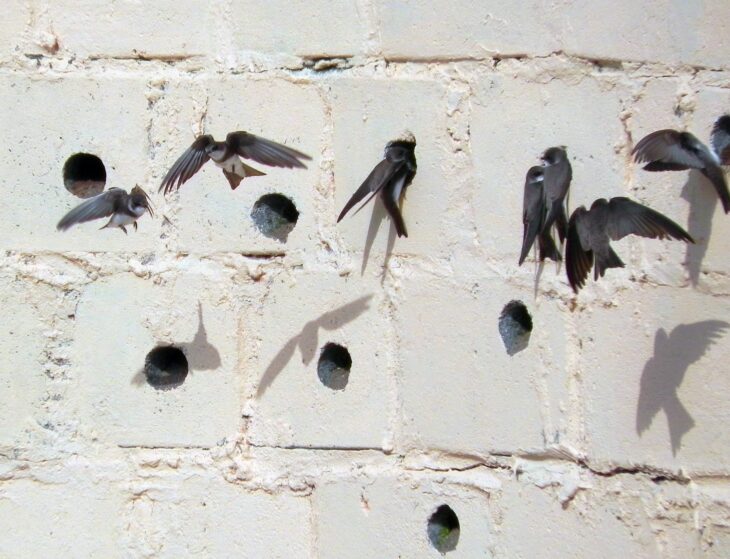
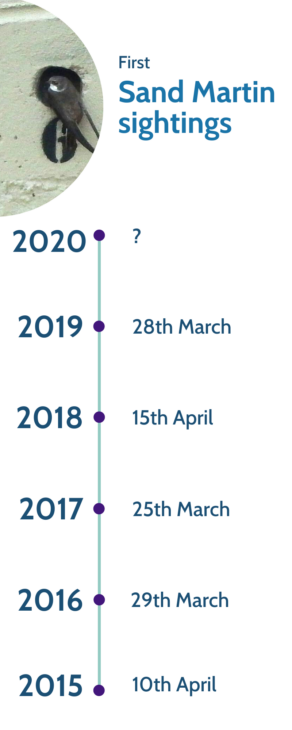
Sand martins begin to arrive back at the Basin towards the end of March and beginning of April. As you can see, first sand martin sightings have been fairly unpredictable over the last 5 years. The window between the first sand martin sightings at the wall has been 22 days between 2015 and 2019. Unsurprisingly, migrating sand martins were severely delayed in 2018 during the ‘Beast from the East’ and notably nesting numbers were significantly less than previous years. In addition, 2019 marked the first year we had no sand martins nesting in the wall. These population dips can also be due to climactic factors in their wintering grounds, such as severe droughts.
Sensational Spring Sightings
As well as our expected spring visitors, now is the time of year to keep our eyes peeled for ‘unexpected’ and exciting rarities on the Basin. On a sunny Sunday in April last year, three avocets were spotted amongst the usual wader congregations. In early April in 2018, a marsh harrier was seen patrolling the Lurgies and during the same week in 2017 a smattering of sandwich terns were spotted.
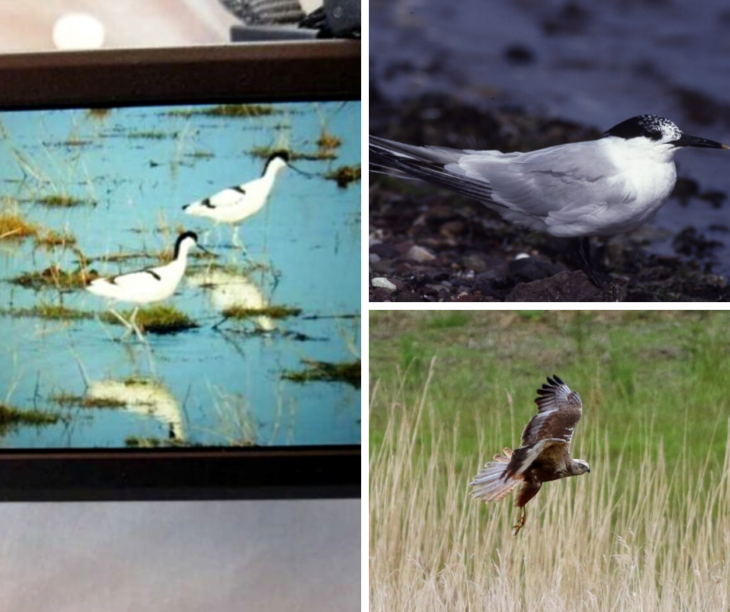
So, as you can see, there’s plenty to look forward to for staff and visitors alike!
If you’re wanting to catch a glimpse of – what could be – the last kingfisher sighting of spring 2020, or hoping to be the first to spot an osprey, Montrose Basin Visitor Centre is open 7 days a week between 10:30am and 5:00pm. Once you’re here, our staff and volunteers will be more than happy to point out well-used kingfisher and osprey perches, or the best areas of the Basin for a walk.
Let us know when you think our kingfisher will depart this year and when you think we’ll see our first osprey on our Facebook page.
Rachel Mackay-Austin
Seasonal Visitor Centre Assistant / Teacher Naturalist
Help protect Scotland’s wildlife
Our work to save Scotland’s wildlife is made possible thanks to the generosity of our members and supporters.
Join today from just £3 a month to help protect the species you love.
Preface
The first day of spring, this year, will fall on 20th March, yet all over Montrose Basin Wildlife Reserve there are tantalising signs that a new season has already started …
